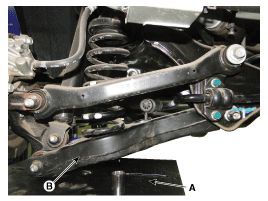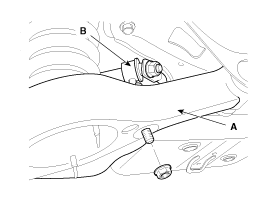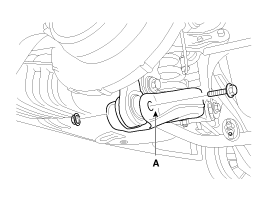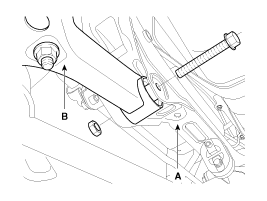 Hyundai Sonata: Rear Lower Arm. Repair procedures
Hyundai Sonata: Rear Lower Arm. Repair procedures
Removal
| 1. |
Remove the rear wheel & tire.
|
| 2. |
Set up the transmission jack (A) under the lower arm (B).
|
| 3. |
Loosen the nut and then remove the rear stabilizer link(B) with
the rear lower arm(A).
|
| 4. |
Loosen the bolt & nut and then remove the rear lower arm (A) with
the rear axle.
|
| 5. |
Loosen the bolt & nut and then remove the rear lower arm (A) from
the sub frame.
|
Installation
| 1. |
Installation is the reverse of removal.
|
Inspection
| 1. |
Check the bushing for wear and deterioration.
|
| 2. |
Check the rear lower arm for deformation.
|
| 3. |
Check for all bolts and nut.
|
| 4. |
Check the cracks or the cutting of the lower arm.
|
 Rear Upper Arm. Repair procedures
Rear Upper Arm. Repair procedures
Removal
1.
Remove the rear wheel & tire.
Tightening torque:
88.3 ~ 107.9 N.m (9.0 ~ 11.0 kgf.m, 65.1 ~ 79.6 lb-ft)
...
 Rear Stabilizer Bar. Repair procedures
Rear Stabilizer Bar. Repair procedures
Replacement
1.
Remove the rear wheel & tire.
Tightening torque:
88.3 ~ 107.9 N.m (9.0 ~ 11.0 kgf.m, 65.1 ~ 79.6 lb-ft)
...
See also:
Driving at night
Because night driving presents more hazards than driving in the daylight, here
are some important tips to remember:
• Slow down and keep more distance between you and other vehicles, as it ma ...
Solenoid valve. Repair procedures
Removal
1.
Remove the battery and the battery tray. (Refer to
"Charging system" in EE group.)
2.
Remove the under cover (A).
...
Power Out Side Mirror Switch. Repair procedures
Inspection
1.
Disconnect the negative (-) battery terminal.
2.
Remove the front door trim panel.
(Refer to the BD group - "Front d ...




